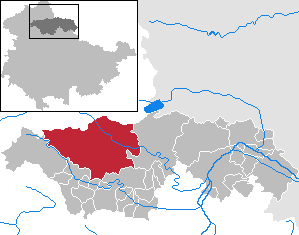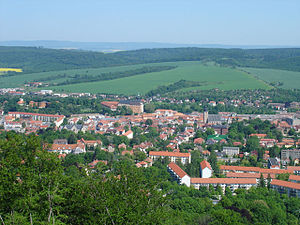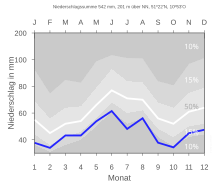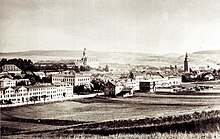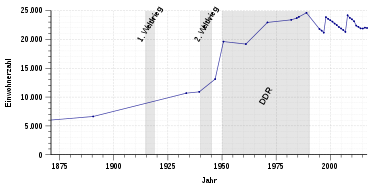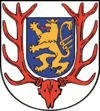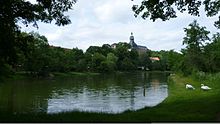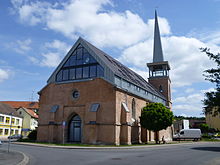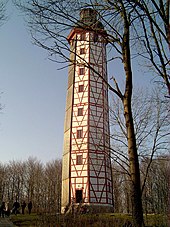Sondershausen
| coat of arms | Germany map | |
|---|---|---|

|
Coordinates: 51 ° 22 ′ N , 10 ° 52 ′ E |
|
| Basic data | ||
| State : | Thuringia | |
| County : | Kyffhäuserkreis | |
| Height : | 208 m above sea level NHN | |
| Area : | 201.21 km 2 | |
| Residents: | 21,290 (Dec. 31, 2019) | |
| Population density : | 106 inhabitants per km 2 | |
| Postal code : | 99706 | |
| Primaries : | 03632, 036020 (Schernberg, Thalebra ), 036330 (Großberndten, Himmelsberg, Immenrode, Kleinberndten, Straussberg) | |
| License plate : | KYF, ART, SDH | |
| Community key : | 16 0 65 067 | |
| LOCODE : | DE SDH | |
| City structure: | 11 districts | |
City administration address : |
Markt 7 99706 Sondershausen |
|
| Website : | ||
| Mayor : | Steffen Grimm (independent) | |
| Location of the district town of Sondershausen in the Kyffhäuserkreis |
||
Sondershausen is in the north of the state of Thuringia located central city and the county seat of Kyffhäuser circle . It extends in the valley of the Wipper between the ridges of Hainleite in the south and Windleite in the north.
Sondershausen was the capital of the Principality of Schwarzburg-Sondershausen until 1918 , and then the state capital of the Free State of Schwarzburg-Sondershausen until 1920 .
Until the Reformation and the Peasants' War , the city with the Jechaburg Abbey was the spiritual center in Northern Thuringia. Due to the residence status it developed over the centuries into a garrison town and an administrative center, a music town and a cultural center. The important Loh orchestra and numerous musicians such as Max Bruch , Franz Liszt and Max Reger shape the city to this day. The annual Thuringian Castle Festival and various musical performances at venues throughout the city are cultural highlights .
As a mining town, Sondershausen has the oldest and deepest still accessible potash mine in the world, some of which has been developed for tourism. This includes a concert hall and a bowling alley at a depth of more than 700 meters. The building complex of the Petersenschacht in Art Nouveau is the symbol for mining and a landmark of the city. The winding tower, modeled on the Paris Eiffel Tower at the request of the Prince , is very important for German industrial architecture.
Sondershausen markets itself as a music and mountain town .
Sondershausen's most historic attraction is the Residenzschloss , which has been shaped by more than seven epochs and can be visited. The exhibits include the Püstrich von Sondershausen , a 57 cm tall bronze figure from the group of Püsteriche found around 1540, and the renowned baroque golden coach , the only one of its kind in Germany. Somewhat more remote is the Zum Possen hunting lodge with a wildlife park and the Possenturm , the largest half-timbered tower in Europe.
geography
location
Sondershausen is located in the Wippertal, a river landscape with the Wipper and the Bebra , which is bordered by the ridges of the Hainleite in the south and the Windleite in the north. The highest point is the Frauenberg at 411 meters.
In the south is Erfurt , the state capital of Thuringia, about 50 km from Sondershausen and in the north the university town of Nordhausen .
geology
Sondershausen lies in the area of the Triassic formation . The rock layers from south to north can be named as follows: In the Hainleite we find the Lower and Middle Muschelkalk . This includes geological outcrops and fossils (mainly cephalopods ( ceratites ) and petrified sea lilies ). After the steep drop, the shell limestone runs north to the Windleite in the middle red sandstone . Ice Age sediments are stored in the western part from Sondershausen to Graß. The landscape is characterized by sandstone and clay soil.
vegetation
On the grove around the antics there are predominantly karst beech forests with red, blood and hornbeams, which are home to over 20 species of orchid , such as the lady's slipper , fox's orchid and the white wood bird . A botanical curiosity is undoubtedly the copper beech , which is said to have appeared spontaneously as a mutation between common beeches around 1680 . All of today's copper beeches are descendants of this rare tree, the mother blood beech in the forest village of Oberspier . Furthermore, can be found at: Rockrose , Carlina vulgaris , horseshoe vetch , Burnet , hill Meier , Fliegenorchis , Bingelkraut , liverwort , Columbine and the woman Mountain Lily . Representatives of the penumbral plants of the region are hard hay and rivins violets , representatives of the shrub flora: privet , eucoat , hazel , woolly snowball , honeysuckle and hornbeam .
climate
Due to its location, Sondershausen belongs to the vegetation zone of the deciduous deciduous forest in the humid climatic area .
The surface shapes of the surroundings, i.e. the valley location of Sondershausen, largely shape the local climate. The annual average temperature is 8 degrees Celsius and the average annual rainfall is 540 mm. Furthermore, there is a precipitation gradient from west to east due to different sea levels and the land level running across the eastern wind deflector, in which two uplift axes of the Kyffhäuser Mountains unite. This forms a barrier in a so-called thunderstorm train route.
City structure
The city of Sondershausen is divided into nine urban and eleven districts. The formerly independent villages Bebra , Jechaburg , Stockhausen and Jecha form the center, the residential area Franzberg and the new development areas Borntal (originated in the 1960s), Östertal and Hasenholz (1970s / 80s) the districts. Sondershausen also includes the districts Berka , Großberndten , Großfurra , Himmelsberg , Hohenebra , Immenrode , Kleinberndten , Oberspier , Schernberg , Straussberg and Thalebra .
history

Early history and the Middle Ages
The area around Sondershausen was demonstrably a transit area for many peoples. The oldest evidence in northern Thuringia from this time was discovered in Bilzingsleben . These are originally preserved fireplaces and workshops at a resting place for hunters and gatherers 350,000 to 400,000 years ago. About 7000 years ago, linear ceramists from the Balkans and the Danube region settled here and began farming and raising cattle. With the end of the Neolithic Age about 4000 years ago, peoples from Bohemia brought metallurgy to the region. From the 7th / 8th In the century BC, the manufacture of tools from iron developed. This time was marked by numerous armed conflicts, which were influenced by the area around the Mediterranean, so that trade relations from the North Sea and Baltic Sea area to the middle Atlantic were disturbed or broken off.
Before the time of Christianization, there was an important cult site of the Germanic inhabitants on the Frauenberg near Sondershausen . A deity, which has not yet been fully identified today, was worshiped, and according to legends it is the hunting goddess Jecha .
Fortifications were built next to the single courtyard settlements. In the pre-Roman Iron Age , the settlements slowly densified. The fortresses and ramparts, as you can still find them around Sondershausen today, were expanded. Finds from the time of the Great Migration , the Huns' invasions , the Thuringian Kingdom and the Franconian period are in some cases difficult to prove. Sondershausen itself was probably built as a Franconian settlement in the 8th century . Richly furnished Franconian aristocratic graves from the late 7th century were found on the Frauenberg.
In 1125, Sondershausen was first mentioned as a settlement under the administration of two servants of the Archbishop of Mainz named Wydego and Remarus . In the 13th century, "Marshals of Sondershausen" are known, who from 1213 were owed to the Thuringian Landgrave and from 1287 to the Archdiocese of Mainz .
The time around 1300 was decisive for the development of the village into a city. The Counts of Hohnstein , who had lived at the Spatenburg since 1263 , were first named as the owners of Sondershausen and helped the town to become a town between 1295 and 1341, as evidenced by the oldest town seal (1341) with Hohnstein heraldry. At that time the city comprised about 400 houses, which were in an irregular square at the foot of a castle (today's castle). After the death of Heinrich V. von Hohnstein in 1356 without a male heir, the town came into the possession of the counts (1697 princely) Schwarzburg dynasty , who expanded Sondershausen as their seat. The astonishingly high cultural standards in relation to its size, which arose from the keeping of the court, shaped the small town. Already in the 14th century a city expansion west of the old town (Oberstadt up to the Lohtor) and a bigger one east of the old town (Neustadt up to the Wippertor) is proven for Sondershausen. At least for the Upper Town, archaeological excavations on Postplatz (1998/99) show that mainly trades such as pottery and tanneries settled here, which were not tolerated within the city due to their environmental pollution from fire, smoke and smell. The citizens at that time were mostly craftsmen and traders whose sphere of activity did not grow beyond the local or regional framework. Since 1391 a schoolmaster was expelled from the city.
There is also evidence of a Jewish community in Sondershausen around 1300 , whose testimony, the Mikveh von Sondershausen , a ritual bath, can still be seen today. The plague pogroms in 1349 wiped out Jewish life from the city for a long time.
Until the Reformation in the 16th century, Sondershausen was also the spiritual center of North Thuringia with the Jechaburg monastery .
Early modern age
The central figure of the 16th century in Sondershausen was Count Günther XL. von Schwarzburg , also called "the rich". In 1534 he had a renaissance castle built in place of the special houses castle and some of its substance.
In 1539 the count confessed to the Reformation in his domain and converted, whereby he knew how to benefit greatly from the secularization of church property.
In the Schmalkaldic War , the county provided auxiliary troops to both parties, so that it led to the occupation of Sondershausen on November 28, 1546 by troops of the Elector Johann Friedrich von Sachsen .
Between 1561 and 1567, one of the most important visitors the city can boast of, William of Orange , stayed with Count Günther XLI as a guest . was related by marriage.

With the Schwarzburg inheritance of 1571, under Count Johann Günther, the Schwarzburg-Sondershausen line , which continued for nine generations and expanded Sondershausen into their residence , was created.
During the Thirty Years' War , the city and its surrounding area were transit areas for imperial and Swedish troops. In 1639 600 Swedes and in the following year 1,500 Swedish riders occupied Sondershausen. At that time, the city also had the devastating city fire of June 3, 1621, the "Thuringian Flood" of May 29, 1613 and the plague years of 1598, 1611 and 1626. The population was temporarily reduced by half. The town church of St. Trinitatis was built on the foundations of the previous building “St. Andreas ”and fell victim to another devastating city fire on June 3, 1621 the year after its completion. Its reconstruction dragged on in stages until 1691.
In the late 17th and 18th centuries, Sondershausen developed as a baroque residence. In 1697, after long efforts, Count Christian Wilhelm von Schwarzburg-Sondershausen succeeded in elevating his dynasty to the rank of imperial prince. In his fifty-year reign he became a symbol of his age in Sondershausen. Between 1680 and 1700 he had the renaissance castle rebuilt, added to and decorated with splendid stucco work and paintings, thus expanding it into a baroque residence, the traces of which are still clearly visible today. The need for representation and the lavish courtship enlivened the city tremendously.
During the Seven Years' War , various troops once again used the city as a transit area.
When fashion changed in the second half of the 18th century, Prince Christian Günther von Schwarzburg-Sondershausen had the palace expanded by adding the west and new north wings and redesigned it in the Rococo style. At that time, the important poet and philosopher Johann Karl Wezel (1747–1819) worked in Sondershausen and wrote the novel “Hermann and Ulrike”, which reproduced court life. One of his teachers was the poet and special house superintendent Nikolaus Dietrich Giseke , who belonged to the circle around Klopstock and received him in 1762 in Sondershausen.
19th and early 20th centuries
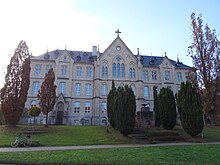
During the Napoleonic Wars , the town, which had around 3000 inhabitants around 1800, was plagued several times by billeting. The Prussian King Friedrich Wilhelm III. stopped on October 16, 1806 while fleeing after the defeat in the battle of Jena and Auerstedt in Sondershausen, which was then punished by looting the city and the castle by the French.
The Loh orchestra later emerged from the royal court orchestra Harmoniecorps . The princely court, which at that time determined the economic and, with its civil service, also the social life of the city, also provided other cultural institutions. In 1825 the Princely Court Theater in the palace area, in 1837 the Lohhalle (music hall) on Lohplatz and in 1883 the conservatory were founded or built.
With the discovery of a sulfur spring in Stockhausen in 1814, the Günthersbad building and the “Zum Erbprinzen” inn were built. However, the spa was closed again in 1842.
In 1835 the "Ebelebener Revolution" took place, in which Günther Friedrich Carl II replaced his father who was incapable of reform and developed a constitutional monarchy with a constitution, elections and parliament, so that life in the city was greatly liberalized. At that time, Sondershausen was in bloom in the Classicist style , shaped by the architect Carl Scheppig , a student of Schinkel . The imposing palace terrace with Alter Wache (1837–1839), the Prinzenpalais from the 1720s and the town hall (1856) were adapted to the taste of late classicism on the market square. In the 1840s, the newly created district, called Carlsstadt , was built west of the old town .
In 1836 the palace park was redesigned into an English landscape garden, the first Rüböllaternen were erected, the first savings bank was founded and the coffee house "Schwarzburg" (later Café Pille ) opened.
In 1869, Sondershausen was connected to the rail network with the construction of the Nordhausen – Erfurt railway line . The railway connection to Bad Frankenhausen was established in 1898 by the Kyffhäuserbahn . In December 2006, traffic on this route was stopped.
In memory of the soldiers from the Principality who fell in the Franco-Prussian War in 1870/71, a war memorial in the form of a victory column was erected and inaugurated in 1876. For traffic reasons, it was moved from the Planplatz to the facilities beyond the Wipper in 1907. The column disappeared in the 1970s, the base is still standing (2012).
The opening of the first potash mine in 1893 marked the beginning of industrialization, which started late in Sondershausen. In 1902, the electrical engineering production of Lindner and Co. started. Potash mining and the electrical industry determined the economic and demographic development of the city in the following hundred years.
In 1905, Prince Karl Günter celebrated the 25th anniversary of the reign in the city. On this occasion, the marketplace was redesigned, roughly as it is today. The highlight was the unveiling of the “Schwarzburgia”, a monument created by Gustav Eberlein in the middle of the market square. It was demolished in 1939.
Until 1918, Sondershausen was the main place of subordination and the capital of the Principality of Schwarzburg-Sondershausen . Between 1920 and 1945 the district of Sondershausen was a Thuringian enclave in the Prussian province of Saxony .
National Socialist Period and World War II
Political opponents from the working class were persecuted as early as the beginning of the Nazi era , but resistance groups such as those around Karl Haferung and Kurt Hafermalz, which are reminiscent of street names in the Borntal residential area , also formed. Between 1934 and 1944, 360 women and men were victims of the country's hospital made compulsory sterilization . During the pogrom night in 1938 , the synagogue of the Jewish community was desecrated. A plaque on the shopping center that stands there today commemorates this church, which was demolished in 1960. From the country's infirmary an unknown huge number of individuals in the Nazi medical murders who was " Operation T4 " killed. A grove of honor with a memorial stone was created for the victims of forced labor at the main cemetery in Brückental . 80 dead, including at least 48 victims of forced labor, including 19 children, rest in the Soviet honorary cemetery on Alexander Pushkin Promenade. A monument erected in 1947 on Güntherstraße commemorates all victims of fascism .
From 1936 to 1945 Sondershausen was a garrison town of the Wehrmacht . Potash shafts 3 and 4, which are no longer in use, were expanded as an army ammunition facility in 1937/1938, in which around 1,000 forced laborers were later used. Other groups of women and men in large numbers had to forced labor afford: in the company wellspring & Co. the company Lindner & Co. on the Good in Großfurra.
→ Main article: Air raid on Sondershausen
Three days before the invasion of US troops, which was initiated with artillery fire, an air raid of 97 (planned 152) bombers of the 9th US Air Force with 113 (planned 221) tons of high explosive and incendiary bombs took place on April 8, 1945 von Sondershausen, who, according to incomplete information, fell victim to 181 civilians. The losses would have been significantly higher if a large part of the population had not fled to the area around the city or found shelter in the castle or brewery cellars. 40% of the housing stock (236 buildings with 1,554 apartments) was destroyed. The town houses in the area of Loh-, Leopold-, Günther- and Hauptstraße suffered total losses. The palace complex was damaged (especially the west wing, also the carousel building and the court theater), the orangery destroyed, the pleasure garden was a crater landscape.
After 1945 and the time of the GDR
After the end of the war, based on the local law on the clearing of rubble in the city of Sondershausen, which provided for all male workers between the ages of 15 and 55 to work for three hours a day as part of the clearing of rubble and reconstruction, began. At the beginning of July 1945 the city, like all of Thuringia, was handed over by the Americans to the Red Army . This made it part of the Soviet zone of occupation and, from 1949, of the GDR .
In 1952, Sondershausen became the district town of the reduced Sondershausen district , which belonged to the newly founded Erfurt district .
Due to the enormous influx of refugees and natural population growth, the number of inhabitants grew very strongly, so that the construction of the new development areas Borntal, Hasenholz and Östertal began in the 1950s , which led to a considerable expansion of the city. With the demolition of the old town (“Black Quarter”), which began in the late 1970s, and the construction of the Wippertor new building area , the city of Sondershausen lost another piece of identity after the bombing-related destruction.
The after the Second World War, first as SAG continuing OPERATION potash mine Glückauf was from 1952 state-owned enterprise . In 1951, a firedamp explosion resulted in 12 dead and 22 injured. The operation formed the basis for the VEB Kombinat Kali to have its headquarters here in 1970 . The second largest company in Sondershausen was VEB Elektroinstallation Sondershausen (EIS). By the end of 1989 it had around 3,200 employees.
Post-turnaround time
After the end of the GDR in 1990, potash mining was gradually discontinued in 1991/1992. The accompanying deindustrialization makes today that unemployment in Sondershausen - as in the whole Kyffhäuserkreis, in 1994 from the previous circle Sondershausen and the former county hall located district Artern was formed - is among the highest in Thuringia.
Electrotechnical articles are still produced in companies such as ELSO , WAGO and SONLUX, but with far fewer employees.
As a result of emigration, especially in the early 1990s, and a population development typical of East Germany with too few births, Sondershausen is continuously losing its inhabitants. Therefore the city changed structurally. In addition to the repair and restoration of the center, the new building areas from GDR times are being dismantled (demolished) or renovated. Public buildings, residential buildings, streets, squares and the infrastructure have been refurbished over the past two decades, and the Dornheide , Bahnbogen and Windleite residential estates in Stockhausen have been built.
The Loh Orchestra, formerly a state institution, now run in the form of a GmbH, continues to successfully defend Sondershausen's reputation as a city of music far beyond the city limits and, in addition to the castle museum, music school, State Music Academy Thuringia and other cultural institutions, shapes the cultural life of Sondershausen.
Incorporations
Especially from the 20th century onwards, the population development fluctuates greatly due to various factors. In 1922 the villages of Bebra, Stockhausen, Jecha and Jechaburg were incorporated, and the three latter were already incorporated again in 1924. From 1944 onwards, bombed-out people, refugees and displaced persons began to move in as a result of the Second World War. In 1950 the villages of Stockhausen, Jecha and Jechaburg were added back to the town of Sondershausen. With the end of the GDR in 1990, a strong wave of emigration began due to high unemployment, and the city continues to lose residents to this day. Therefore, the surrounding villages of Berka, Großfurra and Oberspier were incorporated on December 31, 1997. On December 1, 2007, the unified community Schernberg followed.
| date | Former parish | annotation |
|---|---|---|
| 1922 | Bebra | |
| 1922 | Jecha | Incorporation to Sondershausen |
| 1922 | Jechaburg | Incorporation to Sondershausen |
| 1922 | Stockhausen | Incorporation to Sondershausen |
| 1924 | Jecha | Outsourcing from Sondershausen |
| 1924 | Jechaburg | Outsourcing from Sondershausen |
| 1924 | Stockhausen | Outsourcing from Sondershausen |
| 07/01/1950 | Jecha | Incorporation to Sondershausen |
| 07/01/1950 | Jechaburg | Incorporation to Sondershausen |
| 07/01/1950 | Stockhausen | Incorporation to Sondershausen |
| 03/14/1974 | Himmelsberg | Incorporation to Schernberg |
| 01/01/1996 | Großberndten | Incorporation to Schernberg |
| 01/01/1996 | Hohenebra | Incorporation to Schernberg |
| 01/01/1996 | Immenrode | Incorporation to Schernberg |
| 01/01/1996 | Kleinberndten | Incorporation to Schernberg |
| 01/01/1996 | Straussberg | Incorporation to Schernberg |
| 01/01/1996 | Thalebra | Incorporation to Schernberg |
| December 31, 1997 | Berka | |
| December 31, 1997 | Grossfurra | |
| December 31, 1997 | Oberspier | |
| December 01, 2007 | Schernberg |
Population development
|
|
|
|
Data source: from 1994 Thuringian State Office for Statistics; from 1960 values from December 31, where only the year is given.
politics
City council
The local elections on May 26, 2019 with a turnout of 57.9% led to the following distribution of the 30 seats in the city council:
| Party / list | Seats |
| People's solidarity | 7th |
| CDU | 6th |
| Free voters | 4th |
|
The Left Green |
3 1 |
|
SPD NUBI * |
3 1 |
| AFD | 3 |
| NPD | 2 |
* New Independent Citizens' Initiative
City council chairman is Daniel Pößel (Free Voters), Deputy Mayor is Martin Ludwig (People's Solidarity)
The mayor Steffen Grimm (non-party) also belongs to the Sondershäuser City Council .
In addition to the city council, Sondershausen also has a senior citizens' advisory board and an advisory board for the disabled .
mayor
coat of arms
| Blazon : "The coat of arms shows red deer antlers on a silver background with three lateral and three upper ends, a blue shield between the bars, inside a golden, crowned, red-tongued and armored lion rising to the right." | |
| Justification of the coat of arms: The red stag sticks come from the coat of arms of the landlords, the lion's shield indicates Schwarzburg possessions. Sondershausen castle and rule first came to the Counts of Honstein around 1263 , who placed their red and silver shield between the stag sticks, but later the Schwarzburg lion shield took its place. |
Official seal
"The official seal bears the inscription 'Free State of Thuringia' or 'Thuringia' in the upper half-arch and 'City of Sondershausen' in the lower half-arch and shows the coat of arms [...] in a shield frame in the middle field."
Town twinning
Sondershausen maintains partnerships with Pecquencourt in the Nord department in France (since 1969), Rolla in the United States and with the Lithuanian city of Kazlų Rūda in the Marijampolė district (since 2000).
Culture and sights
Museums
In Sondershausen there is a castle museum with three different exhibition areas. These include a special exhibition area with constantly changing exhibitions by artists and the historical rooms or room settings from six epochs, e.g. B. the blue hall or the unique stone room. Third, the castle houses the natural and cultural-historical area, including the city's history. The most important exhibits include the “ Golden Coach ”, the only one of its type in Germany, and the legendary “ Püstrich ”. Special tours through the castle cellar, show depot , castle tower and the castle park are possible.
Under the town there is a visitor mine , which is the oldest drivable potash mine in the world. The visitors are driven through kilometers of routes that resemble an underground labyrinth. Mining and conveying techniques are shown and a boat trip with real Spreewald barges on the deepest salt lake in the world is offered. There is also a salt slide and a ballroom underground. The concert hall and the bowling alley at a depth of 700 meters are also world records. Since 2007 there has also been a permanent underground exhibition on the subject of army ammunition in potash pits . Cycling races and races are also organized annually under extreme conditions that attract hundreds of athletes to the mine, including the so-called underground marathon .
You can also visit a Jewish bath from the 14th century, excavated in 1999, under the gallery on Schlossberg , see Mikveh von Sondershausen .
The eminent natural scientist Thilo Irmisch spent his whole life in Sondershausen and left behind many insights that were processed in the city museum.
Recreational areas and parks
Amusement and recreation park antics
The area belongs to the hunting lodge “Zum Possen” . On top of it there is the Possenturm (observation tower), the old bear pen from 1867, the Possenbrunnen with a depth of approx. 40 meters and a wet biotope. A large part of the area is taken up by the freely accessible wildlife park with brown bears, red deer , fallow deer , mouflon , wild boars, various species of birds, horses, donkeys, sheep, goats, dwarf rabbits, guinea pigs and chickens. Meerkats , emus and dwarf kangaroos have been living in the zoo for a short time .
In addition to a large holiday complex and a playground, there is also a historic riding hall on the extensive grounds. A restaurant is now housed in the former princely hunting lodge. Events, such as animal exhibitions, are regularly held in a large open space.
Experience Straussberg
In the Straußberg district there is the KiEZ holiday park Feuerkuppe , a bungalow village with a guest house and campsite as well as sports fields, swimming pool, bowling alley and a climbing tower. A variety of leisure activities are offered for every age group. There is also a monkey park, in which the primates can move freely between the visitors, and a summer toboggan run. The district can also come up with a medieval castle complex that can be visited.
Parks
The Sondershausen Castle Park was redesigned from 1837 onwards by Carl Eduard Petzold, who also created the park pond, with the involvement of the castle, town and surroundings (including the Wipper ) according to the principles of a landscape garden, into the “ Princely Park of Sondershausen ”. Towards the end of the Second World War and in the post-war decades, the system was severely impaired until repairs began in 1991.
Another park is located in the city center, near the Trinity Church , the so-called Alte Gottesacker . Among other things, there is the memorial stone for the poet Johann Karl Wezel .
Also in the center is the rose garden , in which the Käthe-Kollwitz- Kindergarten, the building shared by the elementary school “ Käthe Kollwitz ” and the Geschwister-Scholl-Gymnasium Haus II , the three-field sports hall “ Am Rosengarten ” and the Goethe school (Vocational school). A memorial that commemorates the victims of the Second World War is at the center of the area.
Main cemetery
The park-like main cemetery is located in the northeast of the city on a hillside on the Hardt at the entrance to the Brückental. 19,000 people have been buried here between 1898 and today. There are large family graves and other tombs worth preserving.
In the center of an honorary grove for the fallen of World War II and the victims of the air raid on Sondershausen on April 8, 1945, there are 8 large granite steles in a round. On one of them there is the inscription (from 1995): "The dead open our eyes to the living. All victims of war and violence". The soldiers' graves (from 1940 until the end of the war) are on the left, the bomb victims on the right. These are not marked as such, they can only be recognized on the gravestones on the date of death April 8, 1945 (communal grave).
The Association of Displaced Persons commemorates the honor with a memorial stone: "In memory of the victims of flight and displacement".
Buildings
Castle buildings
- The Residenzschloss Sondershausen is the result of a castle and a subsequent renaissance castle and is later expanded, irregular four-wing complex. The west wing, which was built from 1764 to 1771, was purified in the 19th century in a classicist manner by Carl Scheppig ; Particularly noteworthy are the Blue Hall and the octagonal house in the park , which had a revolving dance floor and is now used for concerts. The orangery was lost in the bombing raid on April 8, 1945.
- The former Prinzenpalais (1721–1725). Among other things, it served the prince as his residence from 1835 to 1851 during the palace renovation. The listed building on the market currently houses the district office of the Kyffhäuserkreis.
- The hunting lodge “Zum Possen” (18th century). The ensemble of buildings and park is freely accessible, houses a wildlife park and a restaurant. The Possenturm observation tower is the largest half-timbered building of its kind in Europe.
- The castle Straußberg (around 1200). The castle complex was built as a ministerial seat for the Landgraves of Thuringia , and was later owned by the Counts of Hohnstein and then the Counts of Schwarzburg .
- The castle Furra from the 11th century in the district Großfurra was once a castle of the Lords of Wurmb .
- The Alte Wache has served as a princely guard since it was built by Carl Scheppig in 1837–1839 and is part of the palace terrace ensemble. Today it contains the city's tourist information office.
Civil secular buildings
- town hall
- The Gottschalcksche Haus is a baroque city palace from the 18th century.
- The house I of the Scholl-Gymnasium Sondershausen in Güntherstraße from 1881. A neo-Gothic building with a significant auditorium that on the Singers' Hall Wartburg was modeled.
- House of Art
Sacred buildings
- St. Trinity Church (Protestant, baroque hall church from the 17th century, renovated from 1987 to 1997). Musical events are often held here.
- Cruciskirche , the oldest building in Sondershausen.
- St. Matthias Church in Stockhausen . The historic building is considered to be one of the most beautiful churches in the region.
- St. Elisabeth (Catholic; built 1906/08) with a St. Elisabeth statue by the sculptor Otto Zirnbauer from 1941
- The mikvah . The Jewish ritual bath from the 13th century is one of the oldest of its kind in central and northern Germany.
- Jewish cemetery (Sondershausen)
- → See also: List of churches in Sondershausen
Regular events
The Thuringian Castle Festival , which has been held annually between June and July since 2006 , is the highlight of the city of Sondershausen's cultural program. This is a music festival which, in addition to the musical framework programs, includes a well-known work of music theater that is newly compiled every year and is performed in the courtyard by the Theater Nordhausen / Loh-Orchester Sondershausen .
Another cultural highlight is the Residenzfest, which has been held since 2001 on the first weekend in June. The three-day festival awaits with an extensive musical program, markets and other events.
The city's Rose Monday parade is one of the largest of its kind in Thuringia, making Sondershausen one of the Free State's carnival strongholds. The 12 to 15 clubs with around 800 active carnivalists move about five kilometers across the city.
Further events are the pub nights, where a large number of pubs, restaurants and clubs throughout the city can be visited with a bus shuttle. The Sondershäuser Wine Festival (since 1995) and the Beer Festival (since 2008) each offer a full program for the whole family for three days in August from morning until late at night. Easter and spring festivals, industrial park days, miners days, Advent and Christmas markets round off the year.
In addition to classical music and jazz nights, memorial days and the North Thuringian Culture Night, open-air events with regional rock bands take place in the castle courtyard and on Lohplatz, especially in summer.
music
In addition to the nickname Bergstadt , Sondershausen also has the nickname "Music City". Musical traditions can be traced back to the 16th century.
The court orchestra was first mentioned in 1637 and renamed the Loh-Orchester Sondershausen in 1918, today part of the Theater Nordhausen / Loh-Orchester Sondershausen GmbH. Musicians such as Max Bruch , Gottfried Herrmann , Franz Liszt and Max Reger worked here . The musicologist Hugo Riemann taught at the Princely Conservatory in Sondershausen, where Max Reger was his student for three months. The musicologist Philipp Spitta was transferred from Tallinn to the grammar school in Sondershausen in 1867 . The conservatory founded by Carl Schroeder (1848–1935) in 1883 trained musicians until 1938. One of the best-known students is the Berlin operetta composer Walter Kollo . In addition, the Albert Fischer Choir, the Special Houses Madrigalists, the District Choir Sondershausen-Bad Frankenhausen and the Ecumenical Choir are active in the city in the field of choral singing. Every year, young musicians from many countries can attend the master classes for violin in the castle .
The beautiful Loh Hall played a major role in the musical life of Sondershausen, especially for the “Musiken im Loh” . It was built in 1837 by state master builder Carl Scheppig , with an open orchestra room facing Lohplatz. The last of the famous concerts there took place in 1965, in 1973 the traditional hall was demolished. Only the foundation plate can still be found (2012).
Sondershausen is also the namesake of the Sondershäuser Association of Academic-Musical Connections (SV) ( umbrella organization of the non-striking musical student associations in Germany and Austria). In addition to association celebrations every five years, the SV regularly organizes association conferences and training seminars as well as its own concerts. In the city's castle museum there is a room with historical objects from the association. The association archive is also located in the city.
Sondershausen has been the seat of the Landesmusikakademie since it was founded in 2005 .
Annual musical events include: sheet music with dip ( brunch with a musical supporting program), palace concerts in the Blue Hall of the Residenzschloss, loh concerts by the Loh orchestra in the octagon house and in the Haus der Kunst. In addition to classical music, there are also jazz nights and current music in the city's clubs. In summer, open-air concerts are also held on Lohplatz and in the courtyard. B. given with regional rock bands.
Sports
There are 39 sports clubs and a country and western club in Sondershausen. The clubs offer the following sports: badminton, basketball, disabled / rehab sports, billiards, soccer, handball, judo, karate, bowling, athletics, air sports (ultralight), motor sports, cycling (street, track), riding and driving, Chess, shooting sports, swimming, diving, table tennis, gymnastics / gymnastics, volleyball, hiking, tennis and water skiing.
The speed skater Gunda Niemann-Stirnemann, who was born in Sondershausen, is known beyond the city . The visitor mine offers athletics events with international participation. The underground marathon and the underground bike race are now known. Other regular sporting events in the mine are: the crystal run, the summer biathlon, fencing, shot put and hiking underground.
In addition, the “International Sparkasse Athletics Meeting” takes place in the city every year with many medal winners of the current season. Every year on the third weekend in March there is the "antics run" and on the second weekend in October there is the "city park run".
The best known sports club is the soccer club BSV Eintracht Sondershausen (until 1990 BSG Glückauf Sondershausen). The club played from 1980 to 1987 in the GDR league (second highest division) and was national champion in the Thuringia regional league in 2000 . He then spent five years in the NOFV Oberliga Süd (4th division). The club's venue is the “Am Göldner” sports center with 5,000 seats, 1,700 of which are covered.
Sondershausen also offers two outdoor pools (near the Göldner Stadium and in Großfurra) and two natural pools (in Bebra and Hachelbich).
Societies
From 1932 to 2003 Sondershausen was the seat of the Luther Academy Sondershausen e. V. Citizens interested in culture come together in the Goethe Society and the Johann Karl Wezel Society . Two carnival associations organize one of the largest Rose Monday parades in Thuringia every year.
Surroundings
An excursion destination near Sondershausen is the leisure and recreation park Possen , which is part of the Hainleite. In the area of the Possen the Hainleite changes to a plateau. Here is the Possenturm, the highest lattice tower in Europe (42 m) with a view of the Brocken .
Other destinations are the Spatenberg in the southwest of the city and the Sondershausen roundabout in the south. From the roundabout you get an overview of the entire city and its districts. On the Straussberg there is also Straussberg Castle , an ape park and a summer toboggan run .
The pits of a former potash mine are located under Sondershausen at a depth of 600 m . Today it has been converted into a visitor mine, which offers a variety of activities underground. On November 20, 2007, the American band Queens of the Stone Age played the deepest rock concert in history here.
Economy and Infrastructure
Public facilities
The city is the seat of the district court Sondershausen , which belongs to the district of the regional court Mühlhausen and is responsible for the entire Kyffhäuserkreis.
Companies
Economically, Sondershausen is shaped by the electrical industry and until the 1990s by the potash mine . The oldest potash shaft in the world that is still navigable is located in Sondershausen. Even though potash production was stopped on a large scale, since 2006 industrial salt has been mined again to a small extent (mainly as road salt). The Glückauf mine now serves mainly as a backfill mine and is operated by the Glückauf Sondershausen Development and Security Company mbH (GSES) . Parts of the underground facilities were expanded into a visitor mine at the end of the 1990s . The largest company is currently the production facility of WAGO Kontakttechnik GmbH Co. KG in Sondershausen with over 1000 employees. Spring clips and systems for electrical installations are manufactured. Other relevant companies are Elektroinstallation Sondershausen , Sonlux (Licht- und Elektroinstallation GmbH & Co. KG) and K-UTEC (Kali-Umwelttechnik GmbH, today: K-UTEC AG Salt Technologies), the successor company of the Potash Research Institute of the Central German potash industry .
Military location
The " Karl-Günther-Kaserne " as a military base is currently still the second largest employer in the city with 960 soldiers and civilian employees. With the restructuring of the Bundeswehr in 2011, however, the location will be reduced to 220 permanent staff.
The starting point was the princely guard founded in 1697. Since 1867, the Principality of Schwarzburg-Sondershausen sought to develop Sondershausen into a garrison town. A military convention was concluded with the Kingdom of Prussia , and the city became a Prussian location. In 1871, the company was finally integrated into the Imperial German Army.
The Karl Günther barracks was built around 1900 in the Wilhelmine style. Much of the building was the era of National Socialism for the Wehrmacht built and during GDR times for the NVA continued to be used. The DEFA feature film “ Der Reserveeheld ” was shot inside the barracks in 1965 . After reunification, there were reclassifications through a structural reform of the Bundeswehr. Further modifications and extensions followed. The last major investment of 50 million euros began in 2004. The barracks has one of ten swimming pools for the Bundeswehr and has one of the largest on-site training areas with a shooting range in Thuringia.
The restructuring of the Bundeswehr was officially announced on October 26, 2011, and the Sondershausen site was able to be preserved in a reduced form after a long struggle. On March 23, 2013, the rocket artillery battalion 132 was dissolved, and a training course was set up on January 1, 2014, in which NCOs and sergeants are to be trained. In addition, the driver training center in Erfurt will be relocated to the district town.
2014 are in the local location
- Sergeant / Sergeant Candidate Battalion 1
- Logistic control point 4 of the logistics center of the Bundeswehr in Wilhelmshaven
- Parts of the Bundeswehr service center in Weißenfels
- the driver training center Erfurt
- other departments


traffic
Rail transport
Sondershausen station is a stop for regional express trains and regional trains on the Wolkramshausen – Erfurt railway line . Other stops are Glückauf near Stockhausen , Großfurra and Hohenebra . On the Sondershausen about Sondershausen South, Sondershausen-Jecha and Bad Frankenhausen to Bretleben leading Kyffhäuser rail passenger transport in December 2006 has been set.
Road traffic
The city is located on the B 4 between Nordhausen and Erfurt. Since 2008 the main road no longer runs through the center, but as a bypass road past Sondershausen.
Local public transport
The bus operator in Sondershausen is the regional bus company Unstrut-Hainich- und Kyffhäuserkreis . A well-developed bus system with a modern bus station in the center ensures organized local transport. There are six city lines available. Another 16 lines supply the Sondershausen area and lead to Ebeleben , Greußen , Kelbra , Straussberg , Bad Frankenhausen and Artern , among others .
education
Until 1990 the only librarian school in the GDR was located in Sondershausen. Today there are educational institutions: four primary schools ( Franzberg , Käthe Kollwitz , Östertal , Hohenebra ), two regular schools ( Franzberg , Östertal ), the Staatliche Geschwister-Scholl-Gymnasium Sondershausen (in two buildings), the Staatliche Berufsbildende Schule Sondershausen (vocational high school) , the regional support center for people with learning disabilities, the regional support center with a focus on intellectual development, the state vocational school center Kyffhäuserkreis (with vocational school and librarian school), an education center of the Federal Office for Family and Civil Society Tasks , the Kyffhäuserkreis adult education center with 13 branches, the Kyffhäuserkreis music school, the Carl -Schroeder Conservatory with 15 branches and the Landesmusikakademie Sondershausen .
Personalities
A list of all people currently classified as important, who were born and / or died in Sondershausen and / or worked here in the city, can be found in the list of personalities of the city of Sondershausen .
- Albrecht von Halberstadt (Albertus) (around 1200), poet and canon
- Christian Wilhelm von Schwarzburg-Sondershausen (1647–1721), Count, raised to the rank of imperial prince by Emperor Leopold in 1697, had the Renaissance palace in Sondershausen rebuilt in baroque style and made the city a cultural center of northern Thuringia
- Michael Heinrich Reinhard (1676–1732) Evangelical Lutheran theologian & 1721–1730 Superintendent Sondershausen
- Johann Karl Wezel (1747–1819), poet
- Karl Friedrich Wilhelm von Weise (1779–1851), President of the Chamber in Sondershausen
- Carl Scheppig (1803–1885), a student of Schinkel ; Architect and princely court building officer, classicistic redesign of the residential palace and its surroundings, construction of the main guard and the prince's palace
- Thilo Irmisch (1816–1879), botanist and local researcher
- Eduard Stein (1818–1864), music director and conductor from 1853
- Eugenie Marlitt (John) (1825–1887), storyteller and writer
- Max Bruch (1838–1920), composer and 1867–1870 Kapellmeister in Sondershausen
- Herrmann Petersen (1844–1917), Minister of State in the Principality of Schwarzburg-Sondershausen, lent his name to the Petersenschacht in Sondershausen
- Carl Schroeder (1848–1935), court conductor, composer and founder of the conservatory
- Albert Fischer (1878–1948), singer
- Carl Corbach (1867–1947), violin virtuoso, conductor and head of the conservatory
- Max Reger (1873–1916), composer
- August Reinbrecht (1882–1929), lawyer, first district administrator in the district of Sondershausen , administrator of the principality of Schwarzburg-Sondershausen
- Elisabeth Busse-Wilson (1890–1974), historian
- Michael Kohl (1929–1981), lawyer and Deputy Foreign Minister of the GDR
- Olaf Koch (1932–2001), conductor and university professor, chief conductor of the Halle Philharmonic and rector of the Hanns Eisler University of Music in Berlin
- Ronald Paris (* 1933), painter
- Günther Jahn (1933–2011), painter and graphic artist
- Vera Lengsfeld (* 1952), civil rights activist, politician ( Bündnis 90 / Die Grünen , CDU since the end of 1996 ) and publicist
- Jörg Hoffmann (* 1963), luge rider
- Gunda Niemann-Stirnemann (* 1966), speed skater
- Volker Strübing (* 1971), writer, songwriter and animator
- Franziska Gehm (* 1974), children's and youth author
literature
- Friedrich Apfelstedt : Architectural and art monuments of the principality of Schwarzburg-Sondershausen. First booklet: The subordination . Bertram, Sondershausen 1886. (Reprint: Donhof, Arnstadt 1993, ISBN 3-86162-013-8 )
- Hendrik Bärnighausen: Historical buildings and sights in Sondershausen . Donhof, Arnstadt 1990, ISBN 3-86162-004-9 .
- Bruno Falley, Siegfried Lange: Sondershausen. (= Thuringian cities. Issue 11). Perthes, Gotha 1994, ISBN 3-623-00972-5 .
- 875 years Sondershausen - a font for the anniversary . Ed .: City of Sondershausen, Starke printing works, Sondershausen 2000, ISBN 3-9805829-7-3 .
- Helmut Röttig: Sondershausen. From the past . Röttig picture archive, Sondershausen 2001, OCLC 176913566 .
- Sondershausen - Faces of a City 1990 to 2010. Ed .: City of Sondershausen, Druckerei Starke, Sondershausen 2010, ISBN 978-3-00-032395-9 .
See also
Web links
Individual evidence
- ^ Population of the municipalities from the Thuringian State Office for Statistics ( help on this ).
- ↑ Thuringian Association of the Persecuted of the Nazi Regime - Association of Antifascists and Study Group of German Resistance 1933–1945 (Ed.): Local history guide to sites of resistance and persecution 1933–1945. (= Guide to local history. Volume 8). Erfurt 2003, ISBN 3-88864-343-0 , p. 178.
- ^ Manfred Ohl: April 1945, the end of the war in Sondershausen. In: Home and Destruction. April 8, 1945 in Sondershausen. Exhibition Schloßmuseum Sondershausen 1995. Booklet, pp. 9–10.
- ↑ Thomas Blumenthal: Anatomy of an attack. The bombing of the city of Sondershausen on April 8, 1945 . Munich 2002, p. 94.
- ^ Rudolf Zießler: Sondershausen. In: Götz Eckardt (Ed.): Fates of German architectural monuments in the Second World War. Volume 2, Henschel-Verlag, Berlin 1978, pp. 496-497.
- ^ Helmut Röttig: Sondershausen. From the past . Röttig picture archive.
- ↑ Jan Eik , Klaus Behling : classified. The greatest secrets of the GDR . Verlag Das Neue Berlin, Berlin 2008, ISBN 978-3-360-01944-8 , p. 68.
- ^ StBA: Changes in the municipalities in Germany, see 1997
- ^ StBA: Changes in the municipalities in Germany, see 2007
- ↑ Main statute of the city of Sondershausen § 3 paragraph 1, July 1, 2009.
- ↑ New Thuringian Wappenbuch . tape 2 , 1998, ISBN 3-9804487-2-X , pp. 30 .
- ↑ Main statute of the city of Sondershausen § 3 paragraph 4, July 1, 2009.
- ↑ Sondershausen brochure, page 5
- ↑ Daniel Koch: Queens Of The Stone Age: Stoner in the Stollen ( Memento of the original from February 10, 2008 in the Internet Archive ) Info: The archive link was automatically inserted and not yet checked. Please check the original and archive link according to the instructions and then remove this notice. . In: Intro. November 22, 2007.
- ↑ As of 2010; from: Sondershausen - Faces of a City 1990 to 2010, Strong Pressure
- ↑ kyffhaeuser-nachrichten.de

